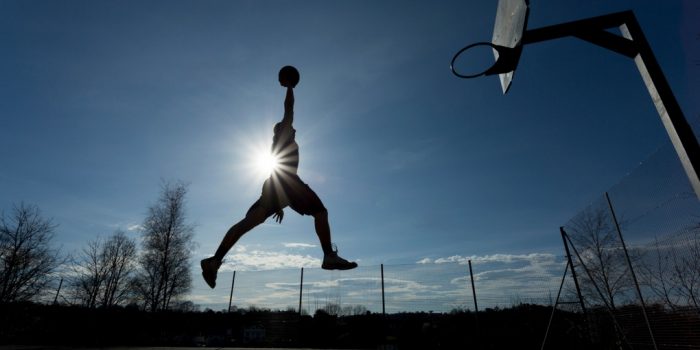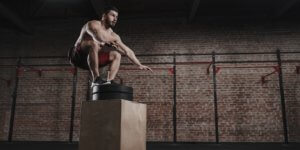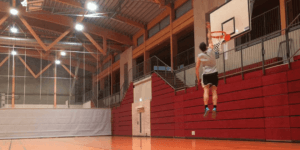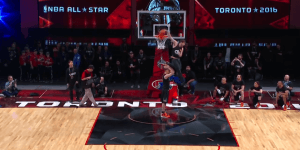In order to successfully learn how to dunk a basketball you have to master two things:
- You must have a great vertical jump. (Find out how high you need to jump with the Dunk Calculator)
- Your jumping and dunking technique has to be good
The first point is pretty obvious. If you can't jump high enough, there is no way you will ever learn how to dunk on a regular rim. If you want to improve your vertical jump, check out the vertical jump program that improved my vertical jump by 8 inches during last off-season.
The second point is less obvious. But, think about it: Being able to dunk doesn't just depend on raw athleticism. It is also a skill to be learned and practiced. There are a lot of very strong powerlifters out there who will never make a dunk. They are very strong, but they lack the necessary coordination and technique to focus their strength.
This article is going to show you three different ways to make a dunk, the strengths and weaknesses of each style and what you have to keep in mind when trying to dunk.
How to Dunk Off One Foot
This is the most common technique and, for the majority of athletes, the easiest way to dunk. The movement patterns are almost identical to a layup making the one-foot dunk-technique easy to learn for experienced basketball players.
One-foot dunkers are often tall and lanky with a build similar to track and field high-jumpers. An example of an excellent dunker who prefers to jump off of one foot is the two-time Dunk Contest Winner, Zach Lavine:
A one-foot dunk is highlighted by a longer than usual second to last step (often called penultimate step by athletic trainers), which lowers the centre of gravity of a jumper. This is then followed by a quick and explosive takeoff where the jumping leg bends relatively little and acts as a lever transforming speed into height.
Find a very detailed description of one foot jump technique here.
Strengths of one-footed dunk technique:
- Can be performed very quickly to avoid blocks
- Relatively easy to perform in-game as the movement pattern is similar to lay-ups
- In addition to jumping high it is also easy to jump long this way
Weaknesses:
- One-foot dunks are usually also one-handed dunks and therefore you should be able to palm the ball
- Heavy athletes or very muscular athletes often have problems with this technique because incredibly high forces are on only one knee often resulting in lower jumps or even knee problems
My Tip For One-Foot Jumpers:
The Vert Shock vertical jump training is the perfect training program for one-foot jumpers. There are no heavy weightlifting exercises that slow you down. Instead, the training focuses on advanced plyometric exercises that will make you more explosive and bouncier.
How to Dunk Off Two Feet
This technique seems to divide basketball players. Some pick it up naturally and others can barely jump over a phone book this way. Two-foot dunks are harder to perform for most athletes, but the technique provides potential for some of the most powerful and spectacular dunks.
There are a lot of NBA players who prefer to jump off of two feet, but the most spectacular is probably Blake Griffin.
Two-foot dunks are often preferred by bigger and more muscular players. These jumps rely less on quickness and "bounce" and more on sheer power. Two-foot jumpers are often very good at squatting and are able to jump very high from a standstill.
To perform two-foot dunks, jumpers bend their knees very deeply and spend a lot more time on the ground loading the jump. This increased time during takeoff is useful because it allows the athlete to transfer force into the ground thereby improving height. Using this approach makes it more difficult to transform speed into jump height making a fast approach far less useful than in one-foot jumping.
If you want to know more about two-foot jump technique check out this post.
Strengths of two-footed dunk technique:
- Very powerful and spectacular
- Don't require a long approach, can be performed from a standstill
- Are less demanding for knees and ankles
Weaknesses:
- Require more time and are therefore easier to block
- More difficult to perform in-game as one more step is needed, often resulting in travels (which are never called)
My Tip For Two-Foot Jumpers:
The Jump Manual is a vertical jump training program that is very well suited for two-foot jumpers. The creator of the Jump Manual, Jacob Hiller, is a two-foot jumper himself - this is reflected in the program. A combination of weightlifting and plyometrics will help you to get the most out of your vertical jump!
How to Alley-Oop
Alley-oops are very popular with basketball players trying to dunk for the first time because they can really concentrate on the jump and don't worry about dribbling the ball. Being able to swing the arms to gain extra momentum can make the difference between a failed dunk and completed dunk.
Watch JJ Barea (5'9") using the self-alley-oop to try a dunk:
The problem with alley-oops? The timing is really difficult. It has to be 100% perfect or otherwise dunks become harder instead of easier.
Advantages of alley-oops:
- Jump technique doesn't matter
- You don't have to palm the ball
- You can swing the arms much more to gain extra height
Problems of alley-oops:
- Good passer needed as timing is very hard
If you are interested in a very motivating example of someone who used an alley-oop to make his first dunk (at 42 years old!!) read this epic SI piece: How a 42 Year old learned to dunk
What is better? - One foot jumping vs two-foot jumping
If you want to learn how to dunk, you want to pick the jump technique that allows you to reach the highest vertical.
So the question is: Do you jump higher off one foot or two feet?
The answer to this questions depends on a lot of different things. Age, weight, body type all play a role. In the following paragraph I want to explain why some athletes jump higher off one foot while others excel at two-feet jumping:
Weight:
One foot jumping is characterized by a very short ground contact time. World-class jumpers touch the ground for less than 0.12 seconds during takeoff. This leads to extremely high forces because a single leg has to produce all the upward movement in such a short period of time.
Of course, these forces increase linearly with increasing body weight. Therefore Olympic high-jumpers are usually build more like marathon runners and less like football players. Every unnecessary pound adds to the forces during take-off, and at some point the muscles and tendons of the jumping leg are just not strong enough any more to support all the weight.
So if your are a lean and lanky athlete, then one-foot jumping is for you. Otherwise you might be better served jumping off two-feet.
Body type:
Two foot jumpers spend a lot more time on the ground during take-off than one-foot jumpers. This allows them to generate a lot of force through the muscles of the calves, quads, glutes and hips. While one-foot jumpers rely heavily on elasticity and "bounciness", two-foot jumps are more reliant on strength and power. This is one of the reasons why football players are excellent two-foot jumpers - they have really strong lower bodies!
So, if you are a muscular guy, two-foot jumping is for you!
Age:
Single leg jumping with it's high impact forces and dependence on the elasticity of muscles and tendons works best for young athletes. With increasing age, the tendons and muscles lose their elasticity and springiness and the risk of injury gets higher and higher. That's why a lot of basketball players start to rely more and more on their two-foot jump as they get older. And the winner of the Olympic high jumping contest are almost always below 30.
So if you are older than 30 years, it is probably better to work on your two-foot jumping - you have a better chance of improvements and less risk of injury!
Technique:
Often times, basketball players have used one-leg jumping their whole life. It's just a much more natural movement because it's used every single time someone goes for a layup. On the other hand, volleyball players are often used to two-foot jumping because it is the most common way to jump when trying to block or spike. So, if you have all the suppositions to be a great two-foot jumper, but you get barely of the ground this way, it's probably because of a lack of technique.
Try to work on two foot jumping and you will see increases very quickly as your body adapts to the new technique! It is like working on your off-hand dribble for the first time, at first it's awkward, but you get better quickly!
Alright, that's it. What is your preferred dunk technique? Let me know in the comments!

Founder of thehoopsgeek.com. A passionate basketball enthusiast and coding geek, Andy combines a love for sports with technology.









